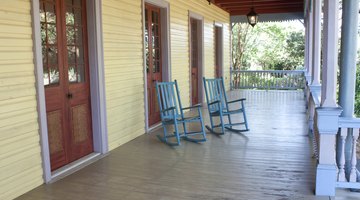How to Paint a Rocking Chair
Online instructional videos join refinishing experts in making the same basic point: When repainting wood furniture, such as a rocking chair, the proof is in the preparation.

Things You Will Need
- Household soap
- Bucket
- Rags
- Deglossing chemicals
- Paint stripper
- Paintbrush
- 120-, 150- and 220-grit sandpaper
- Triangular pad sander
- Wood primer
- Spray equipment
- Gloss or semigloss enamel
- Thinner
- Respirator
- Clear polyurethane finish
In other words, the quality of the finished product is directly proportional to the time and effort you put into sanding and filling the wood and deglossing the old finish. The only major difference between repainting a rocking chair and repainting any other type of chair is that wet paint on the rockers can mark the floor. An easy way to avoid this is to coat them with polyurethane.
-
Wipe down the chair you are about to paint with soapy water and assess its condition. If the old finish is relatively intact, you probably don't need to remove it, but if it's cracked and peeling, you should remove as much of it as possible. This usually requires a combination of stripping with a chemical stripper and sanding.
-
Degloss the finish if you don't plan on removing it. Use a commercial deglossing product, which you may have to mix with water according to the manufacturer's recommendations. If the paint is properly deglossed, you can paint over it without priming first.
-
Move the chair outdoors or into a workroom if you need to strip it. Cover the floor with newspaper, spread the stripper on with a paintbrush, let it work until the paint bubbles, then scrape it off with a putty knife. Strong paint strippers contain methylene chloride, but you may not need one of these. Strippers made from orange oil are environmentally friendly and safe to use, although they don't work as quickly.
-
Wash the chair with water after stripping and let it dry. Sand off the paint residue with 120-grit sandpaper. If your chair has many curves and contours, invest in a sander with a triangular base. Using one is easier than sanding by hand, and because the base has points, it reaches into corners and cracks.
-
Wipe off the sanding dust with a damp rag, then sand again by hand with 150-grit sandpaper. This smooths out rough areas and depressions left by the coarser paper.
-
Prime any exposed wood with a high-quality wood primer. If you stripped and sanded the chair, prime all of it. Although you can brush the primer and paint with a paintbrush, they are both easier to apply with air spray equipment. The spray effortlessly gets into and covers hard-to-access areas around joints, whereas dabbing a brush into these areas leaves telltale marks. You can rent spray equipment from a local rental outlet.
-
Paint with water- or oil-based gloss or semigloss enamel. Fill the spray cup about two-thirds full with paint, then add about an ounce of thinner and shake. Try the spray, and if it sputters, add a bit more thinner.
-
Put on a respirator, cover anything in the area that you don't want to paint, and spray one coat of paint. Spray everything except the bottoms of the rockers. Let the paint dry, sand it lightly with 220-grit sandpaper, and spray another coat.
-
Wait for the paint to harden -- 48 hours or more -- then turn the chair over and spray a coat on the bottoms of the rockers. Let the paint dry, then spray another coat. When the second coat dries, apply a coat of clear polyurethane and wait for 24 hours before turning the chair over and using it.
Tip
If the chair is upholstered, cover the upholstering with plastic and masking tape before deglossing or stripping.
Warning
Wear rubber gloves and goggles when using paint stripper. It is caustic and can irritate the skin and damage the eyes.
References
Tips
- If the chair is upholstered, cover the upholstering with plastic and masking tape before deglossing or stripping.
Warnings
- Wear rubber gloves and goggles when using paint stripper. It is caustic and can irritate the skin and damage the eyes.
Writer Bio
Chris Deziel has a bachelor's degree in physics and a master's degree in humanities. Besides having an abiding interest in popular science, Deziel has been active in the building and home design trades since 1975. As a landscape builder, he helped establish two gardening companies.
Photo Credits
- Dendron/iStock/Getty Images
- Dendron/iStock/Getty Images
More Articles


